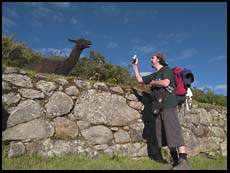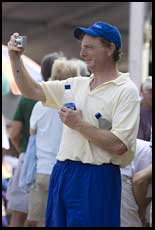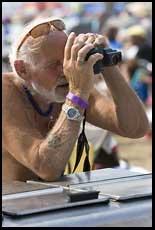
The Best Digital Cameras
by Philip Greenspun; revised April 2007
Site Home : Photography : Compact Digital Cameras

by Philip Greenspun; revised April 2007
Site Home : Photography : Compact Digital Cameras
This review is intended to help you choose the best compact digital camera for your goals. In coming up with these recommendations for my friends, I looked carefully at Canon digital cameras (often the highest technology), Kodak digital cameras (great balance and simple user interfaces), Sony digital cameras (an alternative to Canon), and Olympus cameras, which can be good values and have some unique features such as weatherproofing.
Digital cameras fall into the following categories:
[Each of these categories gets a separate section below. If you don't want to wade through this article, my current best recommendations for most people are the Fuji F30 (about $265; chunky but great for photos indoors without flash) and Olympus 720SW (about $280; waterproof and very compact)]
Decide if you're buying a camera to carry with you all the time, and therefore it must be compact, or if you're buying a camera that you will take out when you are specifically engaged in a photographic project. If you only use a camera during your child's soccer game, for example, the responsiveness and controllability are much more important than the camera's size. For travel, on the other hand, you probably don't want something so heavy that you are tempted to leave it back in the hotel.
In shopping for a good digital camera, the one specification that you can safely ignore is the number of pixels, which has almost nothing to do with image quality. A 3 MP camera will produce acceptable prints up to 8x10" in size. The interesting question is not the number of pixels, but their quality. Is the photo in focus? Is the high contrast and punch of a scene captured? Are the edges of objects rendered sharply? Physically larger and more expensive cameras generally do a better job at satisfying these harder-to-quantify objectives than small and cheap cameras.

Whatever the advertisements might say about megapixels, these cameras have traditionally suffered from mediocre image quality, especially in low light. The sensor in an ultra compact camera is very small and therefore it picks up a lot of noise along with the image. Your images will look "snowy" if taken at twilight or indoors without flash.
Canon and Casio have been the traditional leaders in this category. Casio digital cameras have the style and Canon digital cameras have the image quality. These cameras are about the size of a mobile phone and can be slipped into any pocket. They qualify as "best digital cameras" only if you are willing to extend the phrase with "best digital cameras that fit into a shirt pocket".
There are newer versions of all of these cameras, but in some cases they actually perform worse than the cameras listed and in all cases are more expensive.
Lens Note: Lens focal lengths in this article are specified in terms of the equivalent perspective on an old 35mm film camera. A normal perspective is 50mm. The world of wide angle begins at 35mm and becomes noticeably wide at 28mm, dramatic at 24mm. A moderate telephoto or "zoom" perspective is achieved at 100mm. Sports photography from the sidelines begins at 200mm. The f-number after the focal length indicates the light-gathering power of the lens and is important for indoor or low-light use. The lower the f-number, the better. An f2.0 lens requires only half as much light as an f2.8 lens. When there are two f-numbers, they refer to the light gathering capability at the extremes of the zoom range. The lens may go from a "fast" f2.8 at the wide end to a "slow" f4.9 at the long end, where nearly four times as much light will be required.
Timing Note: "first picture" is defined as the time between turning your "best digital camera" on and capturing the first image. "next picture" is defined as the time between pressing the button on top of your already-woken-up "best digital camera" and capturing an additional image. A digital SLR such as the Canon Digital Rebel XT will turn on almost instantly. Compact digital cameras were often painfully slow until mid-2004 when faster processors became standard. A camera will be referred to as "responsive" if it has been tested and found to turn on and capture within 2.0 seconds, with subsequent pictures being captured in less than 0.6 seconds.

These cameras are small enough to fit in a coat pocket, a purse, or a belt case. They have larger sensors than the ultra compacts, which results in better low-light performance. The Compact cameras can have heavier, higher quality lenses as well. Compact digital cameras are a good choice for travel when you know that you'll want to take a photo every 15 or 20 minutes.
Weaknesses: no optical viewfinder; no orientation sensor--if you take a picture while holding the camera vertically, the image will show up sideways your computer and you'll have to use software to rotate it.
If you are on a tight budget, this is the category of camera that you want. You can get a reasonably good compact digital camera for around $150. Here are some safe low-cost bets:

These cameras aren't much bigger than the compact digital cameras, but they offer a lot more user control. The lenses might be bigger, heavier, and of higher optical quality. Almost all creative compact cameras offer the option of storing images in RAW format, usually proprietary but sometimes in Adobe's standard DNG format. A standard JPEG is convenient for uploading to the Web, sharing with friends, or getting prints. Unfortunately, a lot of shadow and highlight detail that was captured by the sensor can be lost with a standard JPEG. With the RAW format, the photographer has the option of bringing out that shadow or highlight detail in an image editing program on a personal computer (or letting a professional lab do it and make a really great print).
Don't buy one of these cameras unless you are prepared to spend an evening reading the manual and learning the settings. Otherwise the results will be the same as if you had used a simpler compact camera.
This product category seems to have gone out of favor and therefore there isn't much to choose from. Camera companies are concentrating their energies on the "SLR-like" category (below) and SLR category (separate article).
These are physically large cameras, often built around large, heavy, and high-quality lenses. "SLR" stands for "single lens reflex", a camera in which the viewfinder and the film or sensor see through the same lens. In a film camera or true digital SLR, there is a mirror behind the lens that directs the light up into a beautiful bright optical viewfinder. When you press the shutter release, the mirror flips up and lets light through to the sensor. The drawback to this approach is that the LCD display on the back of the camera cannot offer a continuous preview.
The SLR-like cameras get rid of the optical viewfinder found on the standard compact digital camera. In its place you have the screen on the rear of the camera and an electronic viewfinder rather like that on a video camcorder. The electronic viewfinder is good in very dim light but traditionalists will have trouble adjusting to it. One advantage of an SLR-like camera over a true SLR is that the rear LCD display offers a continuous preview.
If you are serious about sports photography, for example, you'll find the true SLRs more responsive and will want to read our "Building a Digital SLR System" article.
SLR-like cameras have lenses that zoom in to substantial telephoto magnifications, up to 200mm. Magnifying the scene also magnifies any shake of the camera body, so unless it is very bright out, you risk blurry pictures at long telephoto settings. The best cure for blur is to mount the camera on a tripod. In-lens image stabilizers are also quite effective if you cannot use a tripod.
Here are some high-value SLR-like cameras:
You should look at a real digital SLR if you need any or all of the following features:
Choosing the right camera system is covered in a separate article on this server: "Building a Digital SLR System".
You might want a lens cleaning kit.
You will definitely need at least one memory card. Most of the compact digital cameras take SD cards. If you are taking JPEG photos rather than RAW, you'll be able to fit between 250 and 500 images in a 1 GB card.
Personally, I have found that it is more convenient to use a single memory card for an entire project or trip rather than juggling multiple cards.
If you want to keep the camera on your belt, consider a small padded case. Lowe and Tamrac are generally the highest quality brands. The manufacturers' own brand cases are generally the lowest quality.
Tamrac publishes a useful fit chart. Lowepro's is a huge PDF.
If you have time and a good local shop, it is best to buy the case in person so that you can make sure you like the fit.
Text and photos Copyright 1993-2006 Philip Greenspun. Camera timings taken from Phil Askey's dpreview.com. philg@mit.edu